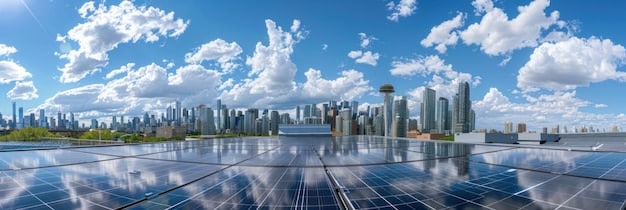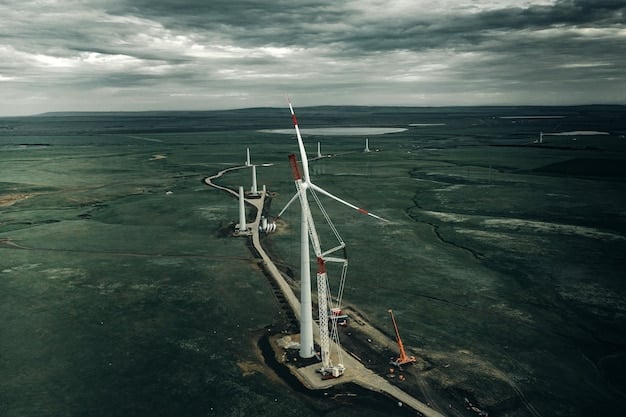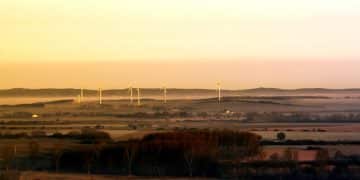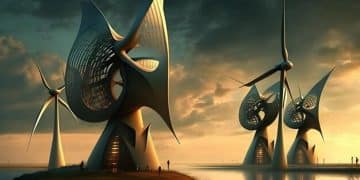The Latest Advances in Renewable Energy Technologies in 2025

The Latest Advances in Renewable Energy: A Comparison of Solar, Wind, and Geothermal Technologies in 2025 reveals significant developments in energy efficiency and storage capabilities, making renewable energy sources more competitive and reliable. These advancements could revolutionize how we power our world.
The quest for sustainable energy solutions is driving remarkable innovation. By 2025, the latest advances in renewable energy: a comparison of solar, wind, and geothermal technologies will likely reshape the global energy landscape, providing cleaner and more efficient alternatives to fossil fuels.
This article will examine these exciting developments, comparing the potential impacts and benefits of each technology.
Understanding Solar Energy Advancements
Solar energy continues to be a frontrunner in the renewable energy sector, with continuous innovation improving its efficiency and affordability. Several key areas are seeing substantial progress that promise to make solar power even more viable by 2025.
Enhanced Photovoltaic Cell Efficiency
One of the most significant advancements lies in the improvement of photovoltaic (PV) cell efficiency. Researchers are exploring new materials and designs to convert a higher percentage of sunlight into electricity.
- Perovskite solar cells are showing promise due to their high efficiency and low manufacturing costs.
- Bifacial solar panels, which capture sunlight on both sides, are becoming more common, increasing energy yield.
- Quantum dot solar cells are being developed to harness a broader spectrum of sunlight.
These technological improvements are making solar energy more competitive with traditional energy sources, ensuring its increased adoption.

Improved Energy Storage Solutions for Solar Power
Efficient energy storage is crucial for making solar power a reliable energy source, especially during periods of low sunlight or at night. Advances in battery technology and other storage methods are paving the way for more dependable solar energy systems.
- Lithium-ion batteries are becoming more efficient and affordable, making them a popular choice for residential and commercial solar storage.
- Flow batteries are being developed for large-scale energy storage due to their long lifespan and scalability.
- Thermal energy storage systems are improving, allowing excess solar heat to be stored for later use.
These advancements in energy storage are making solar power a more consistent and dependable energy source.
In conclusion, solar energy’s continuous advancements in photovoltaic technology and energy storage promise a cleaner and more reliable energy future by 2025. As these technologies continue to evolve, solar power will play an increasingly significant role in meeting global energy demands.
Wind Energy Technology: The Next Generation
Wind energy is another key player in the renewable energy sector, with advancements aimed at boosting efficiency and reducing environmental impact. By 2025, the next generation of wind turbines and related technologies will offer significant improvements.
Larger and More Efficient Wind Turbines
One of the primary trends in wind energy is the development of larger and more efficient wind turbines. These new turbines are designed to capture more wind energy and generate more electricity per unit.
- Taller towers allow turbines to access stronger and more consistent winds at higher altitudes.
- Larger rotor blades increase the swept area, enabling the capture of more wind energy.
- Advanced blade designs improve aerodynamic efficiency, maximizing energy production.
These enhancements are making wind farms more productive and cost-effective.
Offshore Wind Farm Innovations
Offshore wind farms are becoming increasingly important due to the stronger and more consistent winds available offshore. Innovations in offshore wind turbine technology and installation methods are driving this growth.
- Floating wind turbines are being developed to access deeper waters where traditional fixed-bottom turbines are not feasible.
- Advanced installation techniques are reducing the cost and time required to deploy offshore wind farms.
- Improved grid integration technologies are making it easier to transmit offshore wind power to land.

These developments are making offshore wind energy a more attractive and economically viable option.
In summary, the wind energy sector is poised for significant growth by 2025, thanks to advancements in turbine technology and offshore wind farm development. These innovations will enhance wind energy’s contribution to the global renewable energy mix, making it a more reliable and efficient energy source.
Geothermal Energy: Unlocking Earth’s Potential
Geothermal energy, derived from the Earth’s internal heat, offers a consistent and sustainable energy source. Advancements in geothermal technology are expanding its applicability and efficiency, making it an important part of the latest advances in renewable energy: a comparison of solar, wind, and geothermal technologies in 2025.
Enhanced Geothermal Systems (EGS)
Enhanced Geothermal Systems (EGS) are a key area of development, targeting geothermal resources in areas without naturally occurring hydrothermal resources. EGS involves creating artificial fractures in hot, dry rocks deep underground to allow water to circulate and extract heat.
- Advanced drilling techniques are improving the efficiency and cost-effectiveness of creating EGS reservoirs.
- Fluid injection methods are being refined to enhance heat extraction and reservoir sustainability.
- Monitoring technologies are ensuring the safe and environmentally responsible operation of EGS plants.
EGS technology is expanding the geographical availability of geothermal energy, making it accessible in more regions.
Binary Cycle Power Plants
Binary cycle power plants are another significant advancement in geothermal energy technology. These plants allow for the generation of electricity from lower-temperature geothermal resources by using a secondary fluid with a lower boiling point.
- Advanced heat exchangers are improving the efficiency of heat transfer between geothermal fluids and the secondary fluid.
- Optimized plant designs are reducing capital costs and improving overall performance.
- These plants can operate with geothermal resources that are not hot enough for traditional steam turbines.
Binary cycle power plants are making geothermal energy more versatile and accessible.
In conclusion, the geothermal energy sector is benefiting from advancements in EGS and binary cycle power plants, making it an increasingly viable and sustainable energy source. These technologies are unlocking the Earth’s potential to provide clean and reliable energy for communities around the world. As technological progress continues, The Latest Advances in Renewable Energy: A Comparison of Solar, Wind, and Geothermal Technologies in 2025 will continue to advance in geothermal sector.
Comparing the Environmental Impacts
While all three renewable energy sources – solar, wind, and geothermal – are significantly cleaner than fossil fuels, they each have their environmental impacts. Understanding these impacts is essential for making informed decisions about energy policy and infrastructure development.
Land Use
Land use is a significant consideration for all renewable energy projects. Solar farms and wind farms require substantial land areas, potentially impacting natural habitats and agricultural land.
- Solar farms can be sited on degraded or marginal lands to minimize environmental impact.
- Wind farms can coexist with agricultural activities, with turbines spaced to allow for farming.
- Geothermal plants typically have a smaller land footprint compared to solar and wind farms.
Careful planning and siting can minimize the land use impacts of renewable energy projects.
Wildlife Impacts
Renewable energy projects can also impact wildlife. Wind turbines, in particular, have been known to cause bird and bat fatalities.
- Advanced turbine designs and operational strategies are being developed to reduce bird and bat collisions.
- Solar farms can impact desert ecosystems if not properly managed.
- Geothermal plants can release small amounts of greenhouse gases, although significantly less than fossil fuel plants.
Mitigation measures are crucial for minimizing the wildlife impacts of renewable energy projects.
In conclusion, while renewable energy sources are environmentally preferable to fossil fuels, they are not without their impacts. Careful consideration of land use, wildlife impacts, and other environmental factors is essential for ensuring that renewable energy projects are truly sustainable.
Economic Considerations
The economic viability of solar, wind, and geothermal energy is crucial for their widespread adoption. Cost reductions, technological advancements, and supportive policies are driving the economic competitiveness of these renewable energy sources.
Cost Competitiveness
The cost of renewable energy technologies has decreased dramatically in recent years, making them increasingly competitive with traditional energy sources.
- Solar and wind energy are now cost-competitive with fossil fuels in many regions.
- Geothermal energy can provide a stable and predictable energy supply, reducing reliance on volatile fossil fuel markets.
- Government incentives and policies play a critical role in supporting the economic viability of renewable energy projects.
Continued cost reductions and policy support will further enhance the economic attractiveness of renewable energy.
Job Creation
The renewable energy sector is a significant source of job creation, providing employment opportunities in manufacturing, installation, maintenance, and research.
- Solar and wind energy projects create more jobs per unit of energy generated compared to fossil fuel projects.
- Geothermal energy projects often support local economies through job creation and resource development.
- Investing in renewable energy can stimulate economic growth and create new industries.
The economic benefits of job creation further enhance the attractiveness of renewable energy investments.
In summary, the economic considerations of cost competitiveness and job creation are driving the growth of the renewable energy sector. As costs continue to decline and government support increases, solar, wind, and geothermal energy will play an increasingly important role in the global energy economy. These evolutions are part of The Latest Advances in Renewable Energy: A Comparison of Solar, Wind, and Geothermal Technologies in 2025.
Future Outlook for Renewable Energy in 2025
Looking ahead to 2025, the future of renewable energy is bright, with continued technological advancements, policy support, and growing public awareness driving its expansion. Solar, wind, and geothermal energy are all poised for significant growth, transforming the global energy landscape.
Increased Adoption
By 2025, we can expect to see increased adoption of renewable energy technologies across various sectors, including residential, commercial, and industrial.
- Solar energy will continue to expand, driven by decreasing costs and increasing efficiency.
- Wind energy will see significant growth, particularly in offshore wind farm development.
- Geothermal energy will become more widely utilized, thanks to advancements in EGS and binary cycle power plants.
The shift towards renewable energy will be essential for meeting climate goals and reducing carbon emissions.
Policy and Investment
Supportive policies and investments will be crucial for accelerating the transition to renewable energy. Governments around the world are implementing policies to promote renewable energy development.
- Tax incentives, subsidies, and renewable energy mandates are driving investment in renewable energy projects.
- International agreements and collaborations are fostering the development of renewable energy technologies.
- Public awareness and support for renewable energy are increasing, creating a positive feedback loop for further adoption.
These factors will contribute to a cleaner, more sustainable energy future.
In conclusion, the future outlook for renewable energy in 2025 is promising, with increased adoption, supportive policies, and growing public awareness driving its expansion. The latest advances in renewable energy: a comparison of solar, wind, and geothermal technologies in 2025 will play a critical role in creating a sustainable and resilient energy future for generations to come.
| Key Aspect | Brief Description |
|---|---|
| ☀️ Solar Advances | Improved PV cells increase efficiency and reduce costs. |
| 💨 Wind Innovations | Larger turbines and offshore farms enhance energy capture. |
| 🌍 Geothermal Potential | EGS and binary plants unlock broader geothermal access. |
| 💰 Economic Growth | Renewables drive job creation and reduce energy costs. |
Frequently Asked Questions
EGS technology expands geothermal energy use to areas lacking natural hydrothermal resources. This process creates artificial fractures in hot, dry rocks deep underground, enabling water circulation and heat extraction for energy production. The latest advances in renewable energy: a comparison of solar, wind, and geothermal technologies in 2025 shows that EGS significantly broadens geothermal accessibility.
Binary cycle plants generate electricity from lower-temperature geothermal resources. These plants use a secondary fluid with a low boiling point, improving overall geothermal energy efficiency and making geothermal use more versatile. The use of advanced heat exchangers optimizes heat transfer, reducing capital costs.
Advanced turbine designs and operational strategies can significantly reduce wildlife fatalities. These include optimized blade designs, smarter placement of wind farms, and operational adjustments during peak migration seasons. The latest advances in renewable energy: a comparison of solar, wind, and geothermal technologies in 2025 include these wildlife protection measures.
Offshore wind farms capture stronger and more consistent winds compared to onshore locations, leading to higher energy production. Floating wind turbines allow for deeper water access. Improved grid integration technologies are also making it easier to transport offshore wind power to land.
Efficient energy storage is critical for reliable solar power. Lithium-ion batteries are becoming more efficient and affordable. Flow batteries are being developed for large-scale storage. Improved thermal energy storage systems allow for excess solar heat to be stored for later use. The latest advances in renewable energy: a comparison of solar, wind, and geothermal technologies in 2025 depends on the storage.
Conclusion
In conclusion, the renewable energy sector is rapidly evolving, with significant advancements in solar, wind, and geothermal technologies. By 2025, these innovations will drive increased adoption of renewable energy, contributing to a cleaner, more sustainable energy future.
These technologies will play a crucial role in meeting climate goals and reducing carbon emissions, reinforcing the importance of the latest advances in renewable energy: a comparison of solar, wind, and geothermal technologies in 2025.





